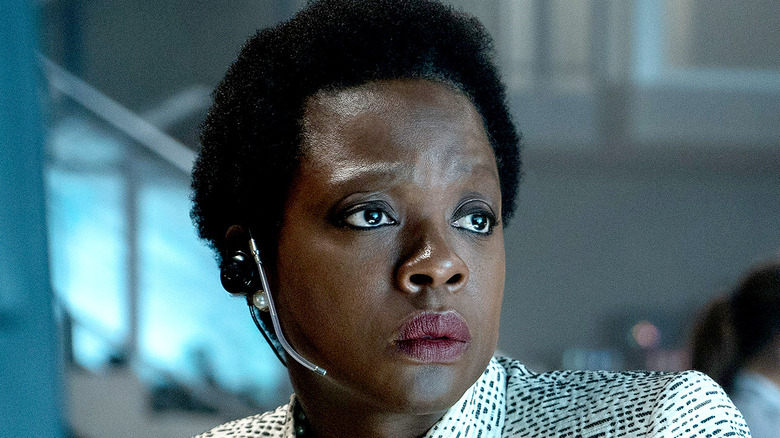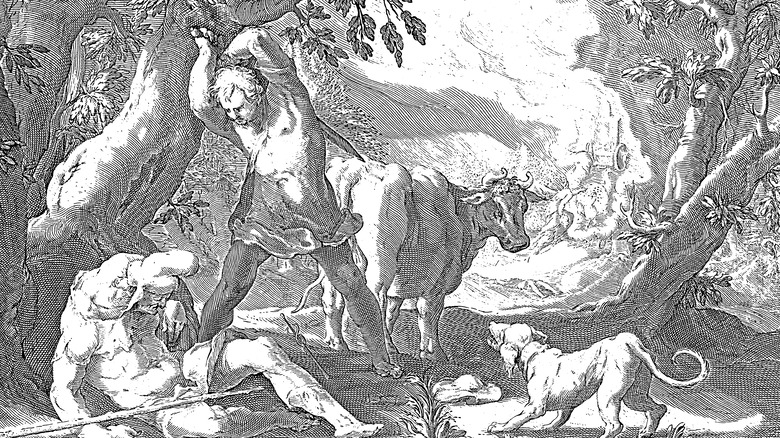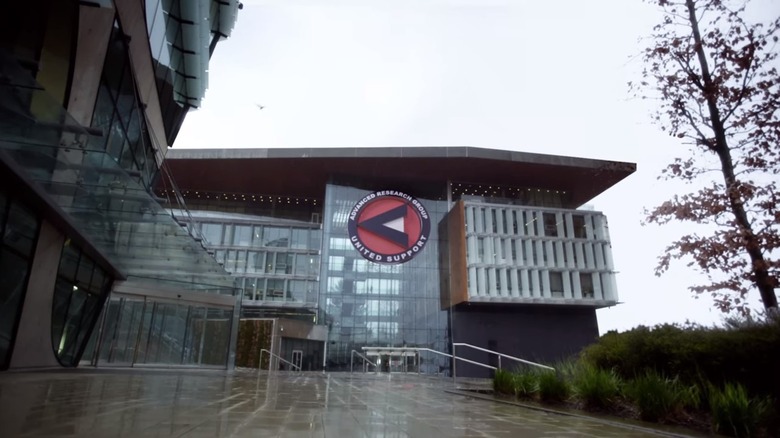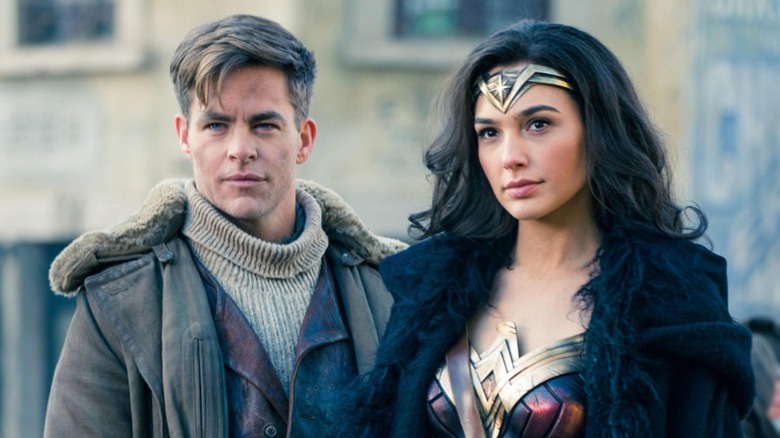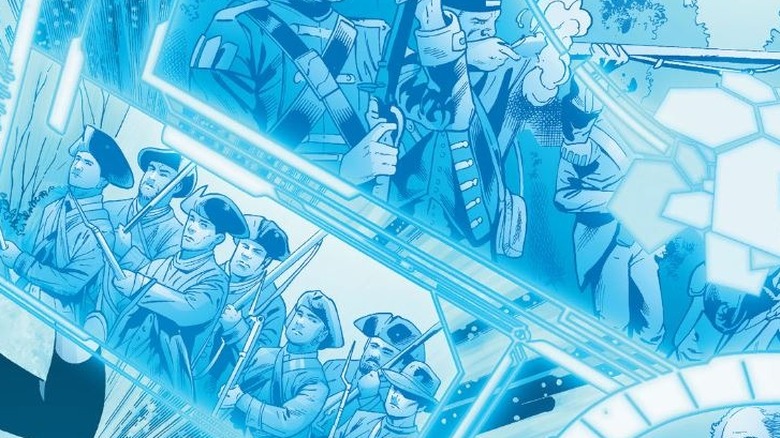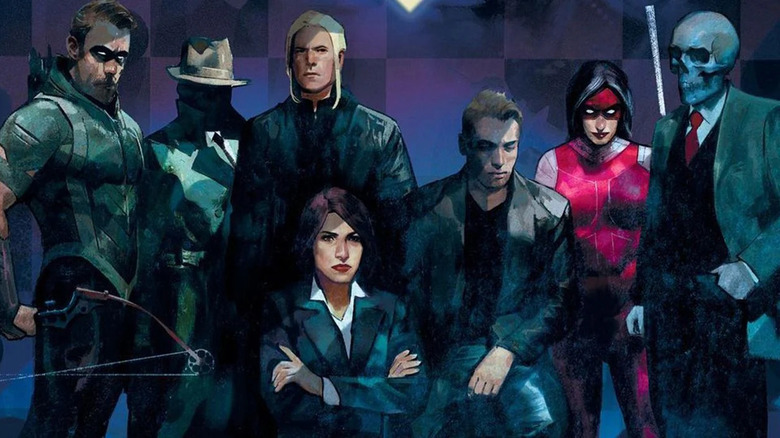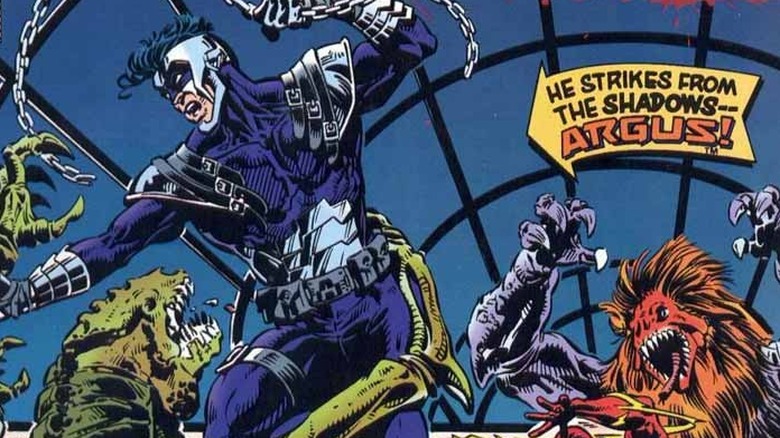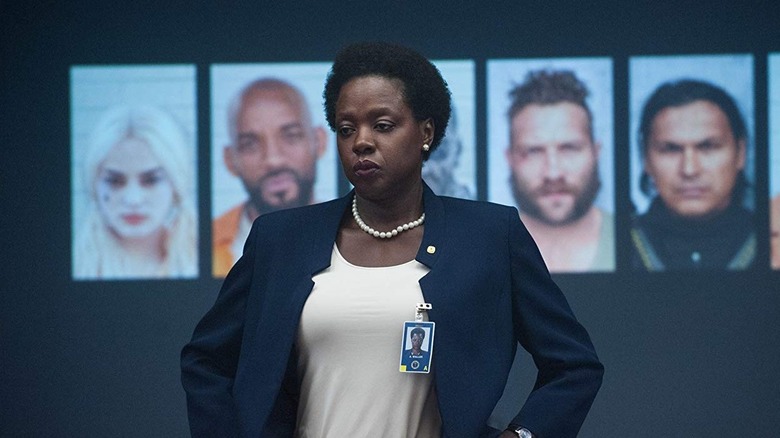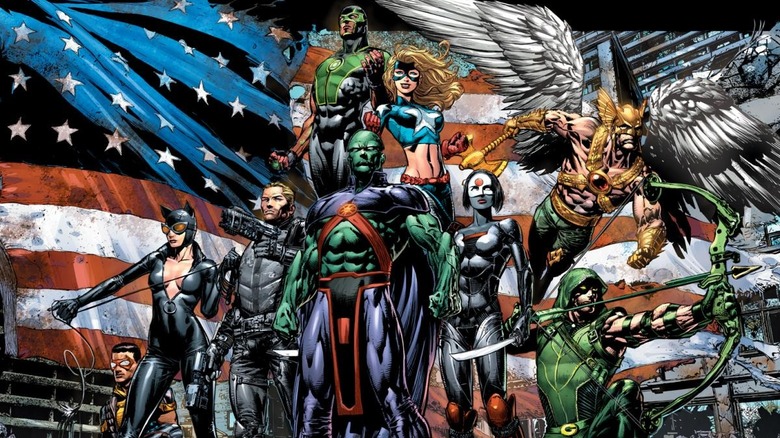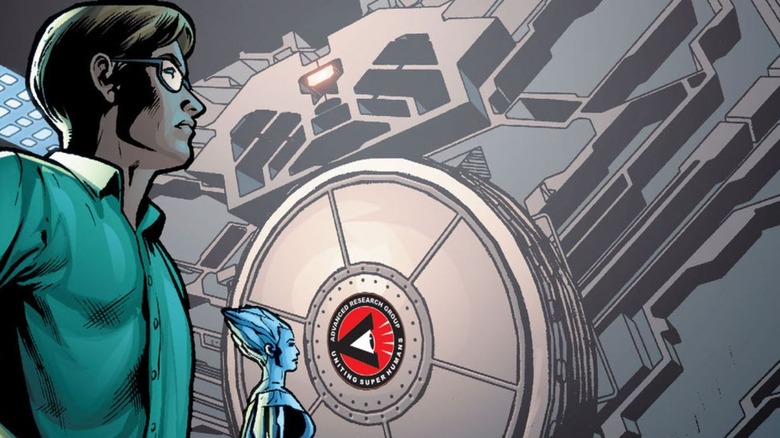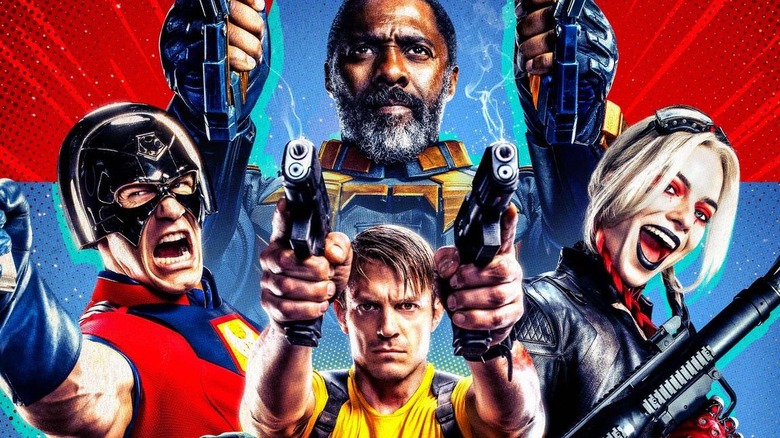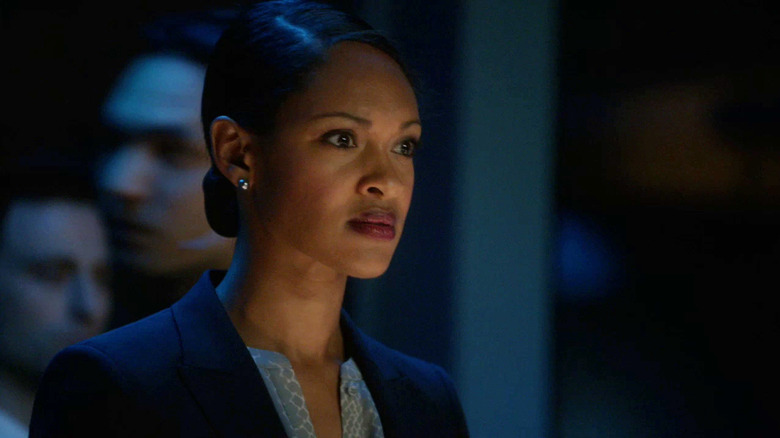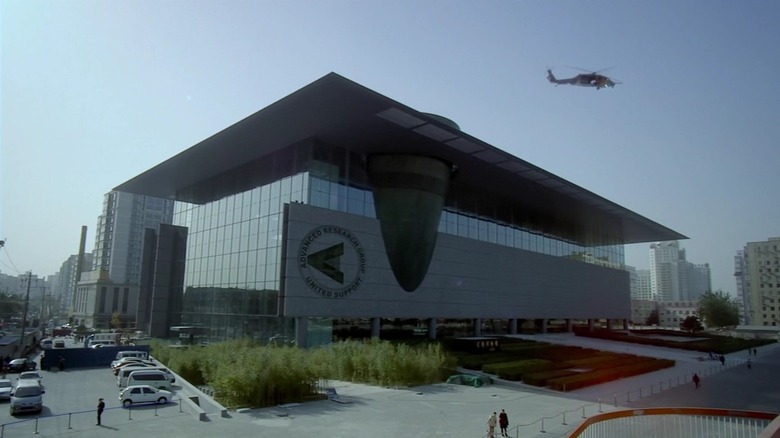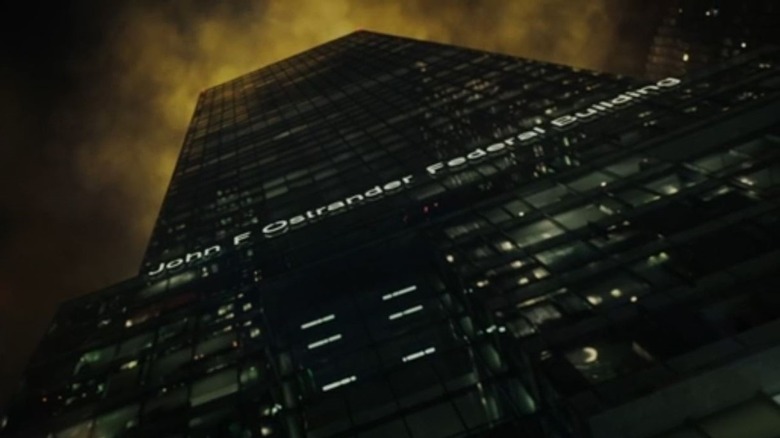The Untold Truth Of DC's A.R.G.U.S.
2008's "Iron Man" changed the world of cinematic superheroes forever in a variety of remarkable ways. Most prominently, it launched the Marvel Cinematic Universe, which rules the modern box office. One of the more subtle influences "Iron Man" has exerted upon the modern movie landscape is ingraining the idea that superhero universes always have a government agency like S.H.I.E.L.D. around, dealing with metahumans and mutants. It's probably not a coincidence, then, that when DC Comics' New 52 initiative rebooted their entire line of comics in 2011, a group called A.R.G.U.S., aka the Advanced Research Group Uniting Super-Humans, entered the fray.
A.R.G.U.S. has been a mainstay within the DC universe ever since. The secretive group has even made appearances in a variety of animated and live-action television and film productions. Different facets of A.R.G.U.S. take precedence, depending on the storyline: At different points in recent DC history, A.R.G.U.S. members have acted as researchers, spies, good guys, despots, and a whole host of other things. One detail always remains the same, however — their eyes are everywhere, and they will find you. This is the untold truth of DC's A.R.G.U.S.
A.R.G.U.S. is named after a figure from Greek mythology
A.R.G.U.S. takes its name from a figure of Greek mythology. Appointed by Hera to guard Io, one of Zeus' mortal lovers, Argus was a giant who sported 100 eyeballs across his body, so that he could keep watch in every direction at once. Unfortunately, this round-the-clock security and surveillance wasn't enough to save him from his killer, Hermes. But Argus did live on, in a way: Hera painted the peacock's feathers with eyes, in tribute to her fallen watchman.
In the modern age of digital surveillance, naming a secret government agency after an all-seeing guardian of the gods paints a pretty clear picture of what they intend to do, regardless of whatever the acronym actually spells out. With near-unlimited access to the billions of digital cameras, cellphones, computers, and databases that exist all around the world, A.R.G.U.S. literally has eyes spread throughout the entire planet. Privacy no longer exists: They can see nearly everywhere at almost any time. Not even the Greek gods could imagine that level of power.
The meaning of the acronym has changed over time
Although the group's purpose usually remains the same, what each letter of the A.R.G.U.S. acronym stands for most certainly has not. In the organization's first appearance in 2012's "Justice League" #7, its acronym is explained as standing for Advanced Research Group Uniting Super-Humans. However, it's later revealed in 2014's "Forever Evil: A.R.G.U.S." #6 that other organizations have used the name and acronym before the modern version snapped it up. This issue specifically names two of them: The Armed Revolutionaries Governing Under Secrecy and the Anonymous Ranger Group of the United States.
In the DCEU films, A.R.G.U.S. shares the same name as its modern comic book counterpart. But in the Arrowverse, the name is adjusted slightly to stand for Advanced Research Group United Support. This makes sense within the confines of that universe, as its version of A.R.G.U.S. has been around far longer than there have been superhumans.
A.R.G.U.S. is founded by Steve Trevor to serve the Justice League
In the comics, the modern version of A.R.G.U.S. is founded to support the Justice League after they repel Darkseid's invasion of Earth in 2011's "Justice League" #1-6. In the five years following the League's creation, A.R.G.U.S. exists to serve as the connection between the League and the rest of the planet. It also often handles the more tedious aspects of superheroic crime fighting: A.R.G.U.S. cleans up after battles, processes arrests, properly disposes of dangerous materials and technologies, and handles much of the group's public relations.
By the time the organization is first introduced in "Justice League" #7, A.R.G.U.S. has existed in this role for over five years, under the command of Steve Trevor. Trevor has performed well in this role — until a villain known as Graves attacks the League using knowledge gained by capturing and torturing Trevor. After these events, Trevor is asked to step down from his position. His superiors feel he needs time to recover, and that he's become far too close to Wonder Woman to perform the job objectively.
Or maybe A.R.G.U.S. was founded during the American Revolutionary War
The notion of Steve Trevor founding A.R.G.U.S. after the debut of the Justice League is eventually challenged in 2014's "Forever Evil: A.R.G.U.S." #6. In this issue, a mysterious agent known only as Mr. Green informs A.R.G.U.S. Agent Etta Candy that the agency was actually founded in the 1700s, in preparation for the American Revolutionary War. Known then as the Armed Revolutionaries Governing Under Secrecy, A.R.G.U.S. supposedly fired the "shot heard round the world" at the battles of Lexington and Concord.
As the nation's needs changed, A.R.G.U.S. became the Anonymous Ranger Group of the United States, patrolling and keeping order throughout the nation's western frontier. According to Mr. Green, A.R.G.U.S. wasn't formed when the Justice League debuted — the group simply changed once more to fit the times, as it always had.
All of this information should be taken with a healthy dose of salt, however. At the end of the issue, Mr. Green is revealed to be the head of the Crimson Men, an evil organization that has supposedly challenged and fought A.R.G.U.S. since the group's formation. As such, it is unlikely that his accounting of A.R.G.U.S. history can be trusted. Moreover, as this plotline has never been addressed again, fans will likely never know how much of what Mr. Green reveals is true or false.
A.R.G.U.S. isn't DC's first secret governmental group
Though A.R.G.U.S. has firmly entrenched itself as the DC universe's version of Marvel's S.H.I.E.L.D., it isn't the first secret agency to occupy such a position. When Amanda Waller originally forms the modern day Task Force X, better known as the Suicide Squad, in 1987's "Legends" #3, she doesn't just oversee the Squad. In addition to running their headquarters at Louisiana's Belle Reve Penitentiary, Waller is placed in charge of "the Agency." This mysterious group is the unofficial arm of the US government that is responsible for monitoring, handling, and supporting the efforts of the illicit Suicide Squad.
Task Force X and its operations don't officially exist in the eyes of the US government, so that it can maintain plausible deniability. Because of this, the Agency is never named until one of its officers, a former police lieutenant named Harry Stein, decides to reorganize it as the outfit known as Checkmate in 1988's "Action Comics" #598. The offices and positions of this group are all named after chess pieces: Low level agents are pawns, leaders are queens and kings, etc. The organization spends much of its time fighting various terrorist threats and eventually even sees superheroes like Alan Scott, the original Green Lantern, become its leader.
The Argus before A.R.G.U.S.
A.R.G.U.S. has many predecessors, but this one is especially unique. Created by Mark Waid and Phil Hester, DC's Argus debuted in 1993's "The Flash Annual" #6. He's a government agent named Nick Kovak who grew up in Keystone City, hometown of both the original Flash, Jay Garrick, and his eventual successor, Wally West. After his father was killed by members of the city's criminal underworld, Nick joined the Army, and later, the FBI. They send him back to Keystone to help with operations targeting the city's many illegal organizations.
Nick eventually uncovers a group of intra-galactic gun-runners. After an unexpected encounter with one of the aliens, his body is altered, granting him superpowers that allow him to become invisible and see across the visual spectrum. Empowered by these new abilities, he takes on the name Argus and helps the Flash kick the alien gangsters out of Keystone City for good.
Amanda Waller is only the second director of A.R.G.U.S.
Amanda Waller is the director of A.R.G.U.S. in nearly every film or TV adaptation. But in the comics, she isn't associated with A.R.G.U.S. until Steve Trevor is forced to step down as director due to his ties with Wonder Woman in 2012's "Justice League" #12. She runs the agency until the events of "Forever Evil" see all three active Justice League teams captured by the Crime Syndicate, an evil version of the Justice League from another dimension. With the entire planet under the direct and total control of an army of supervillains, A.R.G.U.S. is hit hard. Its headquarters in Washington, D.C. are destroyed, and its many prisons and bases around the country are either under siege, demolished, or taken over by the enemy.
When the threat finally passes, Waller is removed for her failure to prevent this disaster. A woman named Sasha Bordeaux replaces her. Originally introduced in 2000's "Detective Comics" #751, Sasha is an ally of Batman and one of the heads of Checkmate, prior to the New 52. Though Waller retains autonomous control over Task Force X, she has not been the director of A.R.G.U.S. for some time now.
A.R.G.U.S. forms their own Justice League of America
In time, Amanda Waller realizes how much damage the Justice League could do if they ever went rogue. She also knows that her Suicide Squad would never be enough to stop them if that were to happen. Because of this, she decides to form her own officially-sanctioned, government-led Justice League of America after she becomes the director of A.R.G.U.S. She specifically chooses each member because she believes they can serve as counters to individual members of the primary League, if it ever comes to that. Waller's League makes their debut in 2013's "Justice League of America" #1.
Led by the recently-demoted Steve Trevor, this Justice League of America recruits Martian Manhunter to oppose Superman, Catwoman and Katana to oppose Wonder Woman, Vibe to oppose the Flash, Green Lantern (Simon Baz) to oppose Green Lantern (Hal Jordan), Hawkman to oppose Aquaman, Doctor Light to oppose Firestorm, Stargirl to oppose Cyborg, and Atomica to oppose Element Woman. The Justice League of America works under Waller to keep the world safe ... until they're utterly defeated by the Crime Syndicate in "Forever Evil." The team disbands in 2014's "Justice League of America" #14.
A.R.G.U.S. has a secret interdimensional prison
When the Crime Syndicate and the Secret Society of Super-Villains take over the planet during the events of "Forever Evil," A.R.G.U.S. is hit hard. 2013's "Forever Evil: A.R.G.U.S." #2 sees many of the organization's secret bases uncovered. Among these facilities are three distinct "Rooms" and a place known as the Circus. The Black Room is a vault where A.R.G.U.S. stores any dangerous supernatural artifacts it comes across. The Red Room is its research facility, where scientists like Cyborg's father Dr. Silas Stone conduct top secret research on alien technology. The Green Room is a super safe house for the president, which exists outside of space and time.
The Circus, on the other hand, is something quite different. When Darkseid invades the planet from Apokolips in 2011's "Justice League" #1-6, the Boom Tube portal he uses to get to Earth weakens the dimensional barriers in the area. Because of this, A.R.G.U.S. secretly builds a facility they nickname the Circus, to contain the breach and capture any creatures that accidentally slip through.
Most of these beings are dangerous, but mindless. They're either killed, detained, or repelled back to their home dimension. Some, however, are sentient, and many of these beings end up joining A.R.G.U.S. in exchange for clemency and room and board in the strange new world they find themselves in.
A.R.G.U.S. hasn't always overseen the Suicide Squad
Though the Suicide Squad is now commonly depicted as an A.R.G.U.S. task force, this wasn't always the case. Originally, Task Force X is simply organized by the Agency, whose director, Amanda Waller, personally oversees their every mission. Eventually, that enigmatic Agency becomes Checkmate, and the Squad is placed under their management, until that agency is destroyed following the events of 2006's "Infinite Crisis."
Things work a little differently in the DC TV shows and movies. In both the Arrowverse and the DCEU, Amanda Waller forms the Suicide Squad only after she has already become the head of A.R.G.U.S. In the comics, she forms the Suicide Squad first. She is eventually put in charge of A.R.G.U.S. as well, after Steve Trevor is forced to resign, ultimately receiving the same kick out the door herself. Yet still, even after she is ousted, Waller retains her control over the Suicide Squad. She might be gone from A.R.G.U.S., but no one can take her favorite project from her.
A.R.G.U.S. is more prominent on TV than in the comics
Despite its prominence, A.R.G.U.S. is still a new addition to the DC universe. Because of this, A.R.G.U.S. has made a relatively small splash within DC Comics canon, basically only showing up when the role of "good spy agency" needs to be filled. The organization is nowhere near as omnipresent within its world as, say, S.H.I.E.L.D. is within the Marvel universe.
This isn't the case when it comes to DC's live-action fare, however. "Arrow" introduces its version of A.R.G.U.S. and Amanda Waller in Season 1. The organization still regularly appears across the vast network of Arrowverse shows: A.R.G.U.S. secretly handles dangerous threats to the United States both internationally and at home through any means necessary. Once supernatural and superhuman threats begin to appear, A.R.G.U.S. is tasked with stopping them as well.
With the Arrowverse's vast variety of content, there's a chance A.R.G.U.S. has a greater number of appearances on television than it does in comic books. Add in the group's burgeoning presence in the DCEU movies, and the live-action side of the scale becomes even more heavily tipped.
In the Arrowverse, A.R.G.U.S. eventually conquers the world
In the Arrowverse, both A.R.G.U.S. and its director are the definition of shady. Though they're ostensibly tasked with protecting human life, this version of the organization takes on a Machiavellian worldview. Amanda Waller's tactics constantly keep the organization balanced on the razor's edge between good and evil.
In Season 1 of "Arrow," Waller hires a mercenary named Edward Fyers to shoot down a commercial airliner full of innocent civilians, just because it contains an assassin. Later, she forces Oliver to join A.R.G.U.S., and threatens to kill an agent's entire family if he doesn't comply with her orders.
Each time she relies on such horrific tactics, it's to stop a massive loss of life. But her willingness to fight evil with evil slowly turns A.R.G.U.S. into an authoritarian, privacy-shattering nightmare. Even after Waller is killed and replaced with the virtuous Lyla Michaels, the agency still struggles with its mission. Michaels has to be pulled back from the brink multiple times to keep her from becoming just like Waller.
Though it hasn't yet come to pass, two possible futures presented in "Arrow" Season 7 and "Legends of Tomorrow" Season 3 involve a dystopian A.R.G.U.S. In these awful visions, the group has taken over the world. Will these futures become a reality? Only time will tell.
The DCEU A.R.G.U.S. headquarters pay tribute to a major name
Apart from forcing supervillains to go on suicide missions, the DCEU's A.R.G.U.S. is a far tamer beast than the Arrowverse's A.R.G.U.S. is eventually revealed to be. This version of the organization seems to primarily be an observational entity that uses the Suicide Squad to act on its information. Led once again by Amanda Waller, the agency is on the up-and-up ... until Waller kills every other agent at headquarters to eliminate witnesses after the Squad arrives to escort her to safety.
Longtime fans of the Suicide Squad likely recognize the name of the skyscraper that bloody scene happens within: It's the John F. Ostrander Federal Building. Like many federal buildings, it's named in honor of an individual who performed some significant service. Unlike most of these buildings, however, this one is named in honor of John Ostrander, the comic book writer who created the Suicide Squad as we know it today. That's not the only Ostrander reference in the DCEU, either — 2021's "The Suicide Squad" features a cameo from the man himself.
